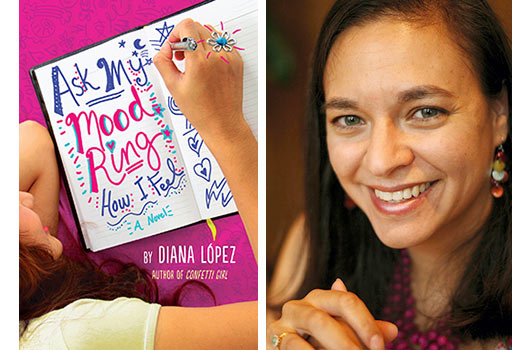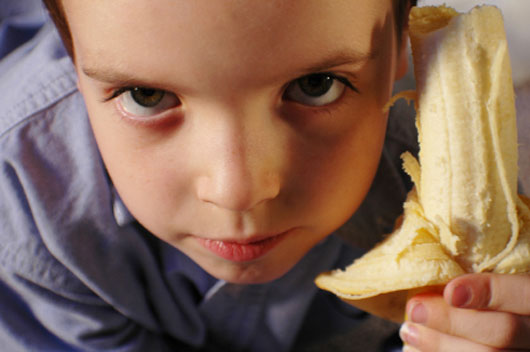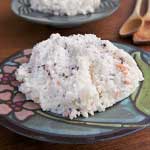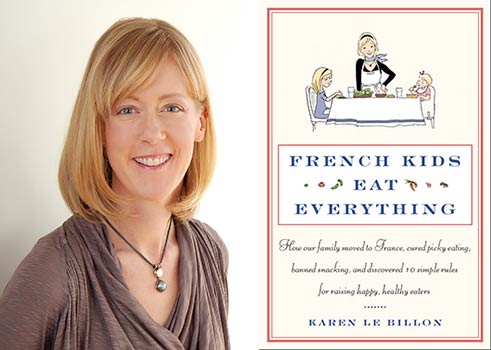
From my years living in France, and being married to a Frenchman, I know a few things about the French and their love of food. They love fresh fruits and vegetables purchased at the marchées. They like food in season. They enjoy long meals and wine, and the whole country is pretty set on a food schedule (yes, you read correctly—the whole country). In other words, the French really really love food. The French are so proud of their cuisine that in 2008, President Sarkozy requested that UNESCO recognize French gastronomy as part of the “Intangible Cultural Heritage of Humanity.” The status was granted in 2010.
As mama to a French/American/Latino toddler, I couldn’t wait to read French Kids Eat Everything! Written in an honest and entertaining tone, Karen Le Billon’s book offers wonderful insight on how French society views eating and food and how they teach children healthy eating habits from an early age. She shares with readers her experiences as a foreign parent in France and as a parent to picky eaters in France (Ooh la la Mon Dieu!) and her journey to discover why it is that French children eat everything from blue cheese to sausage to radishes (and more importantly, offers tips on how to get our children to do the same!)
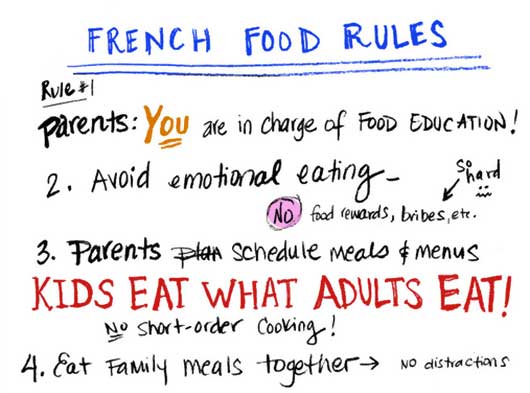
10 FRENCH FOOD RULES
Ms. Le Billon comes up with 10 French food rules to encourage healthy eating in her children. What struck me immediately from reading this list was that I had heard these “rules” before—not in France, but when I was growing up, in the USA with my Ecuadorian parents and during time spent in South America. For example, growing up, I remember my mother saying “No eating in between meals… it will ruin your dinner” and “Comes lo que hay, no hay nada más” (You need to eat what is for dinner, there is nothing else. Karen’s rule number 3—Kids eat what adults eat!) There were no choices to what food we could eat, and we had to eat our soup and arroz con pollo or whatever else we were having. There were never any chicken nuggets and soda was limited to when guests were over. While my friends got chips for lunch, we always got fruit with our sandwiches. Treats were permitted, but they were reserved for special occasions, so there weren’t any cookies, brownies or chips in our cupboards. Like the French, my mom, and many other Latina moms I know take pride in cooking food from scratch. Pleas note that I am not criticizing those mamas who don’t have time to cook from scratch! Trust me, in our kitchen, there are many shortcuts and we do take-out more than I’d care to admit!
Read Related: Similarities in French and Latino Parenting
EATING TOGETHER, AND FOR PLEASURE
For the French, eating is about conviviality (i.e. never eat alone, enjoy food in the company of others!) and about pleasure—that’s right…¡placer!) I found that these are things that the French have in common with Latin American cultures—for us, eating with family and friends is vital as well as using good quality ingredients. Meals are a time for coming together and enjoying each other’s company; unwinding and talking, and like the French, we find pleasure in eating. I mean, what’s a fiesta without food, right?
The French find pleasure in eating, and do not feel guilty about eating croissants, or tartes aux pommes or mousse au chocolat (croissants, apple tarts or chocolate mousse). They certainly do not feel guilty about eating cheese or drinking wine! Children are taught to appreciate all foods in moderation—and that it’s okay to eat mousse au chocolat once in a while!
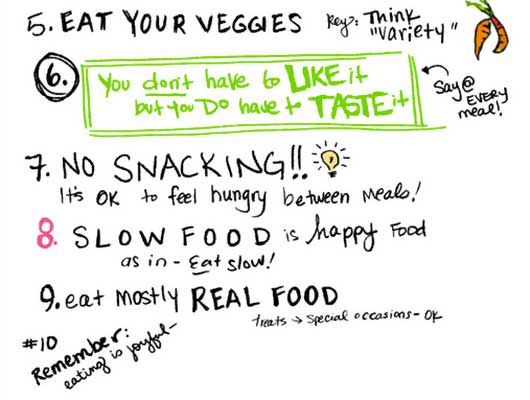
HEALTHY EATING HABITS: START EDUCATING CHILDREN EARLY
Ms. Le Billon explains that in France, there is a true “education” of the palate. Children are encouraged to use their senses to learn about food. They are trained from the time they start school (at age 3) not to snack in between meals, to wait for gouter (afternoon snack) time (4:30pm—once a day!), and to follow an eating schedule (that the whole country follows, remember?) Most school chefs and cooks take pride in cooking meals from scratch in schools. Children are exposed to a variety of fresh food. Schools plan their menus ahead of time, so they do not repeat meals in a given time period. Schools also post their menus so that parents know what their children are eating, and do not serve the same thing at home.
One of my favorite parts of the book was a conversation Ms. Le Billon had with her daughter’s teacher, where she tries to explain that her daughter needs to eat her mid-morning snack because if not, she will not be able to concentrate…the teacher goes on to explain the reasons why this is not possible, and how they are teaching the children about food, about manners, about healthy eating. You may be skeptical but after reading the teacher’s very informed answer, you might be convinced too! And, from what I have seen first-hand, this education goes a long way! Today, I see French college students who grow up to continue eating in this way (making conscious decisions about eating leafy greens at dinner time!) and adults as well.
Read Related: Latin-O-Besity: Changing Your Mindset
CHANGING KID FOOD CULTURE: EVERYONE HAS TO WORK TOGETHER
Perhaps the most important thing I took away from reading this book, and from my experience living in France, is that eating in this way works because everyone in the country works to instill a love of food and healthy eating habits in children. Karen Le Billon explains that “In France, schools, governments, and communities have worked together to create food and education systems that support parents in feeding their children well. In North America, it often seems as if the opposite is true.” In France, there are no concerns about government having too much power, or “telling” schools what to do, and there are rules in place that help to feed children in a healthier way; rules about how much sodium, fried food and ketchup can be served in cafeterias, among other things. In addition, the only drink available with meals is water. If I hadn’t seen it with my own eyes, I’d think this was a French urban myth! I have eaten a variety of food such as couscous, chicken, all types of cheeses and fresh fruit in school cafeterias.
Ms. Le Billon invites us to have a conversation about our children’s food culture. We all know the statistics on childhood obesity in America are alarming! Perhaps we all need to work together to change these trends. Perhaps it is time to work together for the well-being of our children. After reading this book, you might be inspired to question the food we feed our children, and to engage in conversations about the food in our schools and our communities.

